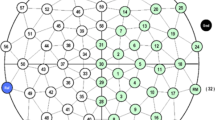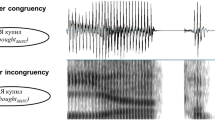Abstract
Neurolinguistic and psycholinguistic studies suggest that grammatical (gender) and phonological information are retrieved independently and that gender can be accessed before phonological information. This study investigated the relative time courses of gender and phonological encoding using topographic evoked potentials mapping methods. Event-related brain potentials (ERPs) were recorded using a high resolution electroencephalogram (EEG) system (128 channels) during gender and phoneme monitoring in silent picture naming. Behavioural results showed similar reaction times (RT) between gender and word onset (first phoneme) monitoring, and longer RT when monitoring the second syllable onset. Temporal segmentation analysis (defining dominant map topographies using cluster analysis) revealed no timing difference between gender monitoring and word onset monitoring: both effects fall within the same time window at about 270–290 ms after picture presentation. Monitoring a second syllable onset generated a later effect at about 480 ms. Direct comparison between gender and first phoneme monitoring revealed a difference of only 10 ms between tasks at approximately 200 ms. Taken together, these results suggest that lemma retrieval and phonological encoding may proceed in parallel or overlap. Word onset is retrieved simultaneously with gender, while the longer RT and the later ERP effect for second syllable onset reflect that segmental encoding continues incrementally to the following phonemes.
Similar content being viewed by others
References
Abdel-Rahman R. A., Sommer W. (2003) Does phonological encoding in speech production always follow the retrieval of semantic knowledge? Electrophysiological evidence for parallel processing. Cognitive Brain Research 16: 372–382
Abdel-Rahman R. A., Van Turennout M., Levelt W. (2003) Phonological encoding is not contingent on semantic feature retrieval: An electro-physiological study on object naming. Journal of Experimental Psychology 29(5): 850–860
Alario X., Ferrand L., Laganaro M., New B., Frauenfelder U. H., Segui J. (2004) Predictors of picture naming speed. Behavior Research Methods, Instruments, & Computers 36: 140–155
Badecker W., Miozzo M., Zanuttini R. (1995) The two-stage model of lexical retrieval: Evidence from a case of anomia with selective preservation of grammatical gender. Cognition 57: 193–216
Besner D. (1987) Phonology, lexical access in reading, and articulatory suppression: A critical review. Quarterly Journal of Experimental Psychology: Human Experimental Psychology 39A: 467–478
Bonin P., Peerman R., Malardier N., Méot A., Chalard M. (2003) A new set of 299 pictures for psycholinguistic studies: French norms for name agreement, image agreement, conceptual familiarity, visual complexity, image variability, age of acquisition, and naming latencies. Behavior Research Methods, Instruments, & Computers 35: 158–167
Caramazza A. (1997) How many levels of processing are there in lexical access?. Cognitive Neuropsychology 14: 177–208
Caramazza A., Miozzo M. (1997) The relation between syntactic and phonological knowledge in lexical access: Evidence from the ‘tip-of-the-tongue’ phenomenon. Cognition 64: 309–343
Dell G. S. (1988) The retrieval of phonological forms in production: Test of predictions from a connectionist model. Journal of Memory and Language 27: 124–142
Dell G. S. (1986) A spreading activation theory of retrieval in sentence production. Psychological Review 93: 283–321
Ducommun C. Y., Murray M. M., Thut G., Bellmann A., Viaud-Delmon I., Clarke S., Michel C. M. (2002) Segregated processing of auditory motion and auditory location: An ERP mapping study. NeuroImage 16: 76–88
Ellis A. W., Franklin S., Crerar A. (1994) Cognitive neuropsychology and the remediation of disorders of spoken language. In: Riddoch M. J., Humphreys G. W. (eds) Cognitive neuropsychology and cognitive rehabilitation. Lawrence Erlbaum Associates, Hove
Fender D. H. (1987) Methods of analysis of brain electrical and magnetic signals. In: Gevins A. S., Remond A. (eds) Handbook of electroencephalography and clinical neurophysiology, (Vol. 1). Elsevier, Amsterdam, pp 355–399
Henaff-Gonon M. A., Bruckert R., Michel F. (1989) Lexicalization in an anomic patient. Neuropsychologia 27: 391–407
Indefrey P., Levelt W. (2004) The spatial and temporal signatures of word production components. Cognition 92: 101–144
Jansma B. M., Schiller N. O. (2004) Monitoring syllable boundaries during speech production. Brain and Language 90(1–3): 311–317
Jescheniak J. D., Schriefers H., Garrett M. F., Friederici A. D. (2002) Exploring the activation of semantic and phonological codes during speech planning with event-related brain potentials. Journal of Cognitive Neuroscience 14(6): 951–964
Laganaro M., Morand S., Schwitter V., Zimmermann C., Camen C., Schnider A. (2009) Electrophysiological correlates of different anomic patterns in comparison with normal word production. Cortex, 45: 697–707
Levelt W. (1989) Speaking: From intention to articulation. MIT Press, Cambridge, MA
Levelt W. J. M., Roelofs A., Meyer A. S. (1999) A theory of lexical access in speech production. Behavioral and Brain Sciences 22: 1–38
Michel C. M., Thut G., Morand S., Khateb A., Pegna A. J., Gravede de Peralta R. (2001) Electric source imaging of human brain functions. Brain Research. Brain Research Reviews 36: 108–118
Michel C. M., Murray M. M., Lantz G., Gonzalez S., Spinelli L., Gravede de Peralta R. (2004) EEG source imaging. Clinical Neurophysiology 115: 2195–2222
Miozzo M., Caramazza A. (1997) The retrieval of lexical-syntactic features in tip-of-the-tongue states. Journal of Experimental Psychology: Learning, Memory, and Cognition 23(6): 1410–1423
Miozzo M., Caramazza A. (1997) On knowing the auxiliary of a verb that cannot be named: Evidence for the independence of grammatical and phonological aspects of lexical knowledge. Journal of Cognitive Neuroscience 9: 160–166
Murray M. M., Camen C., Gonzalez Andino S. L., Bovet P., Clarke S. (2006) Rapid Brain Discrimination of Sounds of Objects. Journal of Neuroscience 26(4): 1293–1302
Murray M. M., Brunet D., Michel C. (2008) Topographic ERP analyses: A step-by-step tutorial review. Brain Topography 20: 249–269
Navarrete E., Basagni B., Alario F. X., Costa A. (2006) Does word frequency affect lexical selection in speech production?. Quarterly Journal of Experimental Psychology 59(10): 1681–1690
Pascual-Marqui R. D., Michel C. M., Lehmann D. (1995) Segmentation of brain electrical activity into microstates: Model estimation and validation. IEEE Transactions on Biomedical Engineering 42: 658–665
Pegna A. J., Khateb A., Murray M. M., Landis T., Michel C. M. (2002) Neural processing of illusory and real contours revealed by high-density ERP mapping. NeuroReport 13: 965–968
Rodriguez-Fornells A., Schmitt B. M., Kutas M., Münte T. F. (2002) Electrophysiological estimates of the time course of semantic and phonological encoding during listening and naming. Neuropsychologia 40: 778–787
Schiller N. O., Bles M., Jansma B. M. (2003) Tracking the time course of phonological encoding in speech production: An event-related brain potential study. Cognitive Brain Research 17(3): 819–831
Schiller N. O., Jansma B. M., Peters J., Levelt W. J. (2006) Monitoring metrical stress in polysyllabic words. Language and Cognitive Processes 21: 112–140
Schmitt B. M., Münte T. F., Kutas M. (2000) Electrophysiological estimates of the time course of semantic and phonological encoding during implicit picture naming. Psychophysiology 37: 473–484
Schmitt B. M., Rodriguez-Fornells A., Kutas M., Münte T. F. (2001) Electrophysiological estimates of semantic and syntactic information access during tacit picture naming and listening to words. Neuroscience Research 41: 293–298
Schmitt B. M., Schiltz K., Zaake W., Kutas M., Münte T. F. (2001) An electrophysiological analysis of the time course of conceptual and syntactic encoding during tacit picture naming. Journal of Cognitive Neuroscience 13: 510–522
Schnider A., Mohr C., Morand S., Michel C. M. (2007) Early cortical response to behaviorally relevant absence of anticipated outcomes: A human event-related potential study. Neuroimage 35(3): 1348–1355
Schriefers H., Jescheniak J. D. (1999) Representation and processing of grammatical gender in language production: A review. Journal of Psycholinguistic Research 28(6): 575–600
Schriefers H., Meyer A. S., Levelt W. J. M. (1990) Exploring the time course of lexical access in production: Picture-word interference studies. Journal of Memory and Language 29: 86–102
Stemberger, J. P. (1985). An interactive activation model of language production. In A. W. Ellis (Ed.), Progress in the psychology of language (Vol. 1). Hillsdale, NJ: Erlbaum.
Van Turennout M., Hagoort P., Brown C. M. (1997) Electrophysiological evidence on the time course of semantic and phonological processes in speech production. Journal of Experimental Psychology: Learning, Memory, and Cognition 23: 787–806
Van Turennout M., Hagoort P., Brown C. M. (1998) Brain activity during speaking: From syntax to phonology in 40 milliseconds. Science 280: 572–754
Van Turennout M., Hagoort P., Brown C. (1999) The time course of grammatical and phonological processing during speaking: Evidence from event-related brain potentials. Journal of Psycholinguistic Research 28(6): 649–676
Vigliocco G., Antonini T., Garrett M. F. (1997) Grammatical gender is on the tip of Italian tongues. Psychological Science 8: 314–317
Wheeldon L. R., Levelt W. J. M. (1995) Monitoring the time course of phonological encoding. Journal of Memory and Language 34: 311–334
Wheeldon L. R., Morgan J. L. (2002) Phoneme monitoring in internal and external speech. Language and cognitive processes 17(5): 503–535
Author information
Authors and Affiliations
Corresponding author
Rights and permissions
About this article
Cite this article
Camen, C., Morand, S. & Laganaro, M. Re-evaluating the Time Course of Gender and Phonological Encoding During Silent Monitoring Tasks Estimated by ERP: Serial or Parallel Processing?. J Psycholinguist Res 39, 35–49 (2010). https://doi.org/10.1007/s10936-009-9124-4
Received:
Accepted:
Published:
Issue Date:
DOI: https://doi.org/10.1007/s10936-009-9124-4




